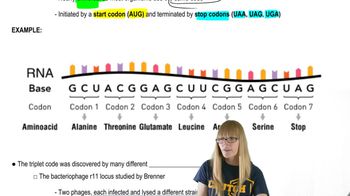Three pairs of genes with two alleles each (A₁ and A₂, B₁ and B₂, and C₁ and C₂) control the height of a plant. The alleles of these genes have an additive relationship: Each copy of alleles A₁, B₁, and C₁ contributes 6 cm to plant height, and each copy of alleles A₂, B₂, and C₂ contributes 3 cm. What height is expected in the F₁ progeny of a cross between A₁A₁B₁B₁C₁C₁ and A₂A₂B₂B₂C₂C₂?
Table of contents
- 1. Introduction to Genetics51m
- 2. Mendel's Laws of Inheritance3h 37m
- 3. Extensions to Mendelian Inheritance2h 41m
- 4. Genetic Mapping and Linkage2h 28m
- 5. Genetics of Bacteria and Viruses1h 21m
- 6. Chromosomal Variation1h 48m
- 7. DNA and Chromosome Structure56m
- 8. DNA Replication1h 10m
- 9. Mitosis and Meiosis1h 34m
- 10. Transcription1h 0m
- 11. Translation58m
- 12. Gene Regulation in Prokaryotes1h 19m
- 13. Gene Regulation in Eukaryotes44m
- 14. Genetic Control of Development44m
- 15. Genomes and Genomics1h 50m
- 16. Transposable Elements47m
- 17. Mutation, Repair, and Recombination1h 6m
- 18. Molecular Genetic Tools19m
- 19. Cancer Genetics29m
- 20. Quantitative Genetics1h 26m
- 21. Population Genetics50m
- 22. Evolutionary Genetics29m
3. Extensions to Mendelian Inheritance
Overview of interacting Genes
Problem 15a
Textbook Question
A plant line with reduced fertility comes to the attention of a plant breeder who observes that seed pods often contain a mixture of viable seeds that can be planted to produce new plants and withered seeds that cannot be sprouted. The breeder examines numerous seed pods in the reduced fertility line and counts 622 viable seeds and 204 nonviable seeds.
What single-gene mechanism best explains the breeder's observation?
 Verified step by step guidance
Verified step by step guidance1
The first step is to recognize that the problem involves a genetic mechanism that affects seed viability. The observation of both viable and nonviable seeds in the same seed pod suggests a genetic phenomenon related to segregation or lethality.
Next, consider the possibility of a single-gene mechanism. A likely explanation is that the reduced fertility is caused by a recessive lethal allele. This means that individuals homozygous for the lethal allele (genotype: ) do not survive, while heterozygous () and homozygous dominant () individuals are viable.
To test this hypothesis, calculate the expected genotypic ratios from a heterozygous cross (). The Punnett square for this cross predicts the following genotypes: , , , and , with a ratio of 1:2:1.
Since the genotype is lethal, only the and genotypes contribute to viable seeds. This results in a phenotypic ratio of 3 viable seeds (1 + 2 ) to 1 nonviable seed ().
Finally, compare the observed data (622 viable seeds and 204 nonviable seeds) to the expected 3:1 ratio. Use a chi-square test to determine if the observed data fits the expected ratio, which would confirm the hypothesis of a recessive lethal allele as the single-gene mechanism.
 Verified video answer for a similar problem:
Verified video answer for a similar problem:This video solution was recommended by our tutors as helpful for the problem above
Video duration:
2mPlay a video:
Was this helpful?
Key Concepts
Here are the essential concepts you must grasp in order to answer the question correctly.
Mendelian Inheritance
Mendelian inheritance refers to the principles of heredity established by Gregor Mendel, which describe how traits are passed from parents to offspring through discrete units called genes. In this context, the observation of viable and nonviable seeds suggests a single-gene trait, where one allele may be dominant and responsible for seed viability, while the other allele leads to nonviable seeds.
Recommended video:
Guided course

Organelle Inheritance
Genetic Ratio
The genetic ratio is a way to express the expected proportions of different genotypes or phenotypes resulting from a genetic cross. In this case, the ratio of viable to nonviable seeds (622:204) can be analyzed to determine if it aligns with a typical Mendelian ratio, such as 3:1, indicating a single-gene trait with one dominant and one recessive allele.
Recommended video:
Guided course

The Genetic Code
Allelic Interaction
Allelic interaction refers to how different alleles of a gene interact to influence a trait. In the scenario presented, the presence of both viable and nonviable seeds suggests that the gene in question may exhibit incomplete dominance or a simple dominant-recessive relationship, where the dominant allele produces viable seeds and the recessive allele results in nonviable seeds.
Recommended video:
Guided course

Interacting Genes Overview

 7:56m
7:56mWatch next
Master Interacting Genes Overview with a bite sized video explanation from Kylia
Start learningRelated Videos
Related Practice
Textbook Question
393
views
